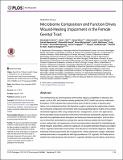Microbiome Composition and Function Drives Wound-Healing Impairment in the Female Genital Tract
Author(s)
Zevin, Alexander S.; Xie, Irene Y.; Birse, Kenzie; Arnold, Kelly; Romas, Laura; Westmacott, Garrett; Novak, Richard M.; McCorrister, Stuart; McKinnon, Lyle R.; Cohen, Craig R.; Mackelprang, Romel; Lingappa, Jairam; Klatt, Nichole R.; Burgener, Adam D.; Lauffenburger, Douglas A; ... Show more Show less
DownloadZevin-2016-Microbiome Composition and Function.pdf (2.565Mb)
PUBLISHER_CC
Publisher with Creative Commons License
Creative Commons Attribution
Terms of use
Metadata
Show full item recordAbstract
The mechanism(s) by which bacterial communities impact susceptibility to infectious diseases, such as HIV, and maintain female genital tract (FGT) health are poorly understood. Evaluation of FGT bacteria has predominantly been limited to studies of species abundance, but not bacterial function. We therefore sought to examine the relationship of bacterial community composition and function with mucosal epithelial barrier health in the context of bacterial vaginosis (BV) using metaproteomic, metagenomic, and in vitro approaches. We found highly diverse bacterial communities dominated by Gardnerella vaginalis associated with host epithelial barrier disruption and enhanced immune activation, and low diversity communities dominated by Lactobacillus species that associated with lower Nugent scores, reduced pH, and expression of host mucosal proteins important for maintaining epithelial integrity. Importantly, proteomic signatures of disrupted epithelial integrity associated with G. vaginalis-dominated communities in the absence of clinical BV diagnosis. Because traditional clinical assessments did not capture this, it likely represents a larger underrepresented phenomenon in populations with high prevalence of G. vaginalis. We finally demonstrated that soluble products derived from G. vaginalis inhibited wound healing, while those derived from L. iners did not, providing insight into functional mechanisms by which FGT bacterial communities affect epithelial barrier integrity.
Date issued
2016-09Department
Massachusetts Institute of Technology. Department of Biological EngineeringJournal
PLOS Pathogens
Publisher
Public Library of Science
Citation
Zevin, Alexander S. et al. “Microbiome Composition and Function Drives Wound-Healing Impairment in the Female Genital Tract.” Ed. Guido Silvestri. PLOS Pathogens 12.9 (2016): e1005889.
Version: Final published version
ISSN
1553-7374
1553-7366